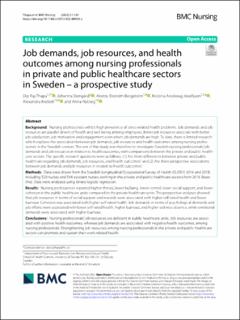| dc.contributor.author | Thapa, Dip Raj | |
| dc.contributor.author | Stengård, Johanna | |
| dc.contributor.author | Ekström-Bergström, Anette | |
| dc.contributor.author | Areskoug Josefsson, Kristina | |
| dc.contributor.author | Krettek, Alexandra | |
| dc.contributor.author | Nyberg, Anna | |
| dc.coverage.spatial | Sweden | en_US |
| dc.date.accessioned | 2022-09-28T09:28:48Z | |
| dc.date.available | 2022-09-28T09:28:48Z | |
| dc.date.created | 2022-06-07T06:52:05Z | |
| dc.date.issued | 2022-06-06 | |
| dc.identifier.issn | 1472-6955 | |
| dc.identifier.uri | https://hdl.handle.net/11250/3022093 | |
| dc.description.abstract | Background: Nursing professionals exhibit high prevalence of stress-related health problems. Job demands and job resources are parallel drivers of health and well-being among employees. Better job resources associate with better job satisfaction, job motivation and engagement even when job demands are high. To date, there is limited research which explores the association between job demands, job resources and health outcomes among nursing professionals in the Swedish context. The aim of this study was therefore to investigate Swedish nursing professionals’ job demands and job resources in relation to health outcomes, with comparisons between the private and public healthcare sectors. The specifc research questions were as follows: (1) Are there differences between private and public healthcare regarding job demands, job resources, and health outcomes? and (2) Are there prospective associations between job demands and job resources in relation to health outcomes?
Methods: Data were drawn from the Swedish Longitudinal Occupational Survey of Health (SLOSH) 2016 and 2018, including 520 nurses and 544 assistant nurses working in the private and public healthcare sectors from 2016 (baseline). Data were analyzed using binary logistic regression.
Results: Nursing professionals reported higher threats, lower bullying, lower control, lower social support, and lower cohesion in the public healthcare units compared to the private healthcare units. The prospective analyses showed that job resources in terms of social support and rewards were associated with higher self-rated health and lower burnout. Cohesion was associated with higher self-rated health. Job demands in terms of psychological demands and job efforts were associated with lower self-rated health, higher burnout, and higher sickness absence, while emotional demands were associated with higher burnout.
Conclusions: Nursing professionals’ job resources are deficient in public healthcare units. Job resources are associated with positive health outcomes, whereas job demands are associated with negative health outcomes, among nursing professionals. Strengthening job resources among nursing professionals in the private and public healthcare sectors can promote and sustain their work-related health. | en_US |
| dc.description.sponsorship | Open access funding provided by University of Skövde. This work was supported by AFA Insurance (grant 150474), the Swedish Research Council for Health, Working Life and Welfare (FORTE) through the Stockholm Stress Center (grant 2009–1758), the Swedish Research Council (VR; grant 2013–0164 and 2013–01646) and the School of Health Sciences at the University of Skövde, Sweden. | en_US |
| dc.language.iso | eng | en_US |
| dc.publisher | BMC | en_US |
| dc.relation.ispartofseries | BMC Nursing;21, Article number: 140 (2022) | |
| dc.rights | Navngivelse 4.0 Internasjonal | * |
| dc.rights.uri | http://creativecommons.org/licenses/by/4.0/deed.no | * |
| dc.subject | Job demands-resources | en_US |
| dc.subject | JD-R model | en_US |
| dc.subject | Occupational health | en_US |
| dc.subject | Demands | en_US |
| dc.subject | Resources | en_US |
| dc.subject | Healthcare | en_US |
| dc.subject | Employment sectors | en_US |
| dc.title | Job demands, job resources, and health outcomes among nursing professionals in private and public healthcare sectors in Sweden – a prospective study | en_US |
| dc.type | Peer reviewed | en_US |
| dc.type | Journal article | en_US |
| dc.description.version | publishedVersion | en_US |
| dc.rights.holder | © The Author(s) 2022 | en_US |
| dc.source.articlenumber | 140 | en_US |
| cristin.ispublished | true | |
| cristin.fulltext | original | |
| cristin.qualitycode | 1 | |
| dc.identifier.doi | https://doi.org/10.1186/s12912-022-00924-z | |
| dc.identifier.cristin | 2029704 | |
| dc.source.journal | BMC Nursing | en_US |
| dc.source.volume | 21 | en_US |
| dc.source.issue | 21 | en_US |
| dc.source.pagenumber | 1-13 | en_US |
| dc.relation.project | AFA Försäkring: 150474 | en_US |
| dc.relation.project | Forskningsrådet för hälsa, arbetsliv och välfärd: 2009–1758 | en_US |
| dc.relation.project | Vetenskapsrådet: 2013–0164 | en_US |
| dc.relation.project | Vetenskapsrådet: 2013–01646 | en_US |

